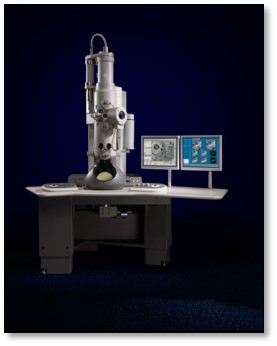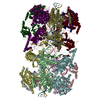[English] 日本語
 Yorodumi
Yorodumi- EMDB-10743: Low resolution structure of Glutaconyl-CoA Decarboxylase from Clo... -
+ Open data
Open data
- Basic information
Basic information
| Entry | Database: EMDB / ID: EMD-10743 | |||||||||
|---|---|---|---|---|---|---|---|---|---|---|
| Title | Low resolution structure of Glutaconyl-CoA Decarboxylase from Clostridium symbiosum | |||||||||
 Map data Map data | ||||||||||
 Sample Sample |
| |||||||||
| Biological species |  Clostridium symbiosum (bacteria) Clostridium symbiosum (bacteria) | |||||||||
| Method | single particle reconstruction / negative staining / Resolution: 15.0 Å | |||||||||
 Authors Authors | Vitt S | |||||||||
| Funding support | 1 items
| |||||||||
 Citation Citation |  Journal: Front Microbiol / Year: 2020 Journal: Front Microbiol / Year: 2020Title: Molecular and Low-Resolution Structural Characterization of the Na-Translocating Glutaconyl-CoA Decarboxylase From . Authors: Stella Vitt / Simone Prinz / Nils Hellwig / Nina Morgner / Ulrich Ermler / Wolfgang Buckel /  Abstract: Some anaerobic bacteria use biotin-dependent Na-translocating decarboxylases (Bdc) of β-keto acids or their thioester analogs as key enzymes in their energy metabolism. Glutaconyl-CoA decarboxylase ...Some anaerobic bacteria use biotin-dependent Na-translocating decarboxylases (Bdc) of β-keto acids or their thioester analogs as key enzymes in their energy metabolism. Glutaconyl-CoA decarboxylase (Gcd), a member of this protein family, drives the endergonic translocation of Na across the membrane with the exergonic decarboxylation of glutaconyl-CoA (Δ ' ≈-30 kJ/mol) to crotonyl-CoA. Here, we report on the molecular characterization of Gcd from based on native PAGE, size exclusion chromatography (SEC) and laser-induced liquid bead ion desorption mass spectrometry (LILBID-MS). The obtained molecular mass of ca. 400 kDa fits to the DNA sequence-derived mass of 379 kDa with a subunit composition of 4 GcdA (65 kDa), 2 GcdB (35 kDa), GcdC1 (15 kDa), GcdC2 (14 kDa), and 2 GcdD (10 kDa). Low-resolution structural information was achieved from preliminary electron microscopic (EM) measurements, which resulted in a 3D reconstruction model based on negative-stained particles. The Gcd structure is built up of a membrane-spanning base primarily composed of the GcdB dimer and a solvent-exposed head with the GcdA tetramer as major component. Both globular parts are bridged by a linker presumably built up of segments of GcdC1, GcdC2 and the 2 GcdDs. The structure of the highly mobile Gcd complex represents a template for the global architecture of the Bdc family. | |||||||||
| History |
|
- Structure visualization
Structure visualization
| Movie |
 Movie viewer Movie viewer |
|---|---|
| Structure viewer | EM map:  SurfView SurfView Molmil Molmil Jmol/JSmol Jmol/JSmol |
| Supplemental images |
- Downloads & links
Downloads & links
-EMDB archive
| Map data |  emd_10743.map.gz emd_10743.map.gz | 806.5 KB |  EMDB map data format EMDB map data format | |
|---|---|---|---|---|
| Header (meta data) |  emd-10743-v30.xml emd-10743-v30.xml emd-10743.xml emd-10743.xml | 7.5 KB 7.5 KB | Display Display |  EMDB header EMDB header |
| Images |  emd_10743.png emd_10743.png | 99 KB | ||
| Archive directory |  http://ftp.pdbj.org/pub/emdb/structures/EMD-10743 http://ftp.pdbj.org/pub/emdb/structures/EMD-10743 ftp://ftp.pdbj.org/pub/emdb/structures/EMD-10743 ftp://ftp.pdbj.org/pub/emdb/structures/EMD-10743 | HTTPS FTP |
-Validation report
| Summary document |  emd_10743_validation.pdf.gz emd_10743_validation.pdf.gz | 180.5 KB | Display |  EMDB validaton report EMDB validaton report |
|---|---|---|---|---|
| Full document |  emd_10743_full_validation.pdf.gz emd_10743_full_validation.pdf.gz | 179.6 KB | Display | |
| Data in XML |  emd_10743_validation.xml.gz emd_10743_validation.xml.gz | 6.1 KB | Display | |
| Arichive directory |  https://ftp.pdbj.org/pub/emdb/validation_reports/EMD-10743 https://ftp.pdbj.org/pub/emdb/validation_reports/EMD-10743 ftp://ftp.pdbj.org/pub/emdb/validation_reports/EMD-10743 ftp://ftp.pdbj.org/pub/emdb/validation_reports/EMD-10743 | HTTPS FTP |
-Related structure data
| Similar structure data |
|---|
- Links
Links
| EMDB pages |  EMDB (EBI/PDBe) / EMDB (EBI/PDBe) /  EMDataResource EMDataResource |
|---|
- Map
Map
| File |  Download / File: emd_10743.map.gz / Format: CCP4 / Size: 42.9 MB / Type: IMAGE STORED AS FLOATING POINT NUMBER (4 BYTES) Download / File: emd_10743.map.gz / Format: CCP4 / Size: 42.9 MB / Type: IMAGE STORED AS FLOATING POINT NUMBER (4 BYTES) | ||||||||||||||||||||||||||||||||||||||||||||||||||||||||||||
|---|---|---|---|---|---|---|---|---|---|---|---|---|---|---|---|---|---|---|---|---|---|---|---|---|---|---|---|---|---|---|---|---|---|---|---|---|---|---|---|---|---|---|---|---|---|---|---|---|---|---|---|---|---|---|---|---|---|---|---|---|---|
| Projections & slices | Image control
Images are generated by Spider. | ||||||||||||||||||||||||||||||||||||||||||||||||||||||||||||
| Voxel size | X=Y=Z: 2.68 Å | ||||||||||||||||||||||||||||||||||||||||||||||||||||||||||||
| Density |
| ||||||||||||||||||||||||||||||||||||||||||||||||||||||||||||
| Symmetry | Space group: 1 | ||||||||||||||||||||||||||||||||||||||||||||||||||||||||||||
| Details | EMDB XML:
CCP4 map header:
| ||||||||||||||||||||||||||||||||||||||||||||||||||||||||||||
-Supplemental data
- Sample components
Sample components
-Entire : Na+-Translocating Glutaconyl-CoA Decarboxylase
| Entire | Name: Na+-Translocating Glutaconyl-CoA Decarboxylase |
|---|---|
| Components |
|
-Supramolecule #1: Na+-Translocating Glutaconyl-CoA Decarboxylase
| Supramolecule | Name: Na+-Translocating Glutaconyl-CoA Decarboxylase / type: complex / ID: 1 / Parent: 0 |
|---|---|
| Source (natural) | Organism:  Clostridium symbiosum (bacteria) Clostridium symbiosum (bacteria) |
-Experimental details
-Structure determination
| Method | negative staining |
|---|---|
 Processing Processing | single particle reconstruction |
| Aggregation state | particle |
- Sample preparation
Sample preparation
| Buffer | pH: 7 |
|---|---|
| Staining | Type: NEGATIVE / Material: uranyl formate |
- Electron microscopy
Electron microscopy
| Microscope | FEI TECNAI SPIRIT |
|---|---|
| Image recording | Film or detector model: OTHER / Average electron dose: 35.0 e/Å2 |
| Electron beam | Acceleration voltage: 120 kV / Electron source: LAB6 |
| Electron optics | Illumination mode: OTHER / Imaging mode: BRIGHT FIELD |
| Experimental equipment |  Model: Tecnai Spirit / Image courtesy: FEI Company |
- Image processing
Image processing
| CTF correction | Software - Name: RELION |
|---|---|
| Final reconstruction | Resolution.type: BY AUTHOR / Resolution: 15.0 Å / Resolution method: FSC 0.143 CUT-OFF / Number images used: 36009 |
| Initial angle assignment | Type: MAXIMUM LIKELIHOOD / Software - Name: RELION |
| Final angle assignment | Type: MAXIMUM LIKELIHOOD |
 Movie
Movie Controller
Controller


 UCSF Chimera
UCSF Chimera






 Z (Sec.)
Z (Sec.) Y (Row.)
Y (Row.) X (Col.)
X (Col.)





















